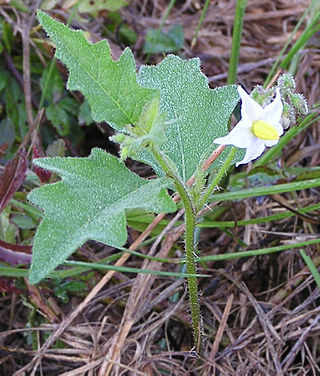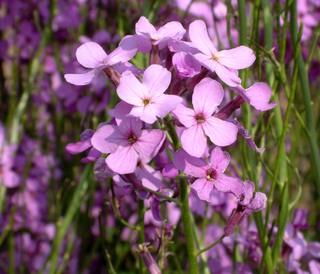
Solanum carolinense, the Carolina horsenettle, is not a true nettle, but a member of the Solanaceae, or nightshade family. It is a perennial herbaceous plant, native to the southeastern United States, though its range has expanded throughout much of temperate North America. The plant is an invasive in parts of Europe, Asia, and Australia. The stem and undersides of larger leaf veins are covered with prickles.

Lonicera japonica, known as Japanese honeysuckle and golden-and-silver honeysuckle, is a species of honeysuckle native to eastern Asia. It is often grown as an ornamental plant, but has become an invasive species in a number of countries. Japanese honeysuckle is used in traditional Chinese medicine.

Euphorbia esula, commonly known as green spurge or leafy spurge, is a species of spurge native to central and southern Europe, and eastward through most of Asia north of the Himalaya to Korea and eastern Siberia.

Hesperis matronalis is an herbaceous flowering plant species in the family Brassicaceae. It has numerous common names, including dame's rocket, damask-violet, dame's-violet, dames-wort, dame's gilliflower, night-scented gilliflower, queen's gilliflower, rogue's gilliflower, summer lilac, sweet rocket, mother-of-the-evening, Good & Plenties, and winter gilliflower.

Verbascum thapsus, the great mullein, greater mullein or common mullein is a species of mullein native to Europe, northern Africa, and Asia, and introduced in the Americas and Australia.

Acer ginnala, the Amur maple, is a plant species with woody stems native to northeastern Asia from easternmost Mongolia east to Korea and Japan, and north to the Russian Far East in the Amur River valley. It is a small maple with deciduous leaves that is sometimes grown as a garden subject or boulevard tree.

Najas minor, known as brittle naiad or brittle waternymph, is an annual aquatic plant, a submersed herb. It is native to Europe, Asia and North Africa from the Netherlands to Morocco east to Japan and the Philippines, including China, Siberia, Central Asia, Iran, Turkey, Ukraine, Germany, France Italy and a host of other countries. It is now introduced to North America and considered a weedy invasive species in the eastern half of the United States from Florida to Oklahoma to New Hampshire to Ontario to South Dakota. This plant prefers calm waters, such as ponds, reservoirs, and lakes, and is capable of growing in depths up to 4 meters.

Solidago canadensis, known as Canada goldenrod or Canadian goldenrod, is an herbaceous perennial plant of the family Asteraceae. It is native to northeastern and north-central North America and often forms colonies of upright growing plants, with many small yellow flowers in a branching inflorescence held above the foliage. It is an invasive plant in other parts of the continent and several areas worldwide, including Europe and Asia. It is grown as an ornamental in flower gardens.

Anaphalis margaritacea, commonly known as the western pearly everlasting or pearly everlasting, is an Asian and North American species of flowering perennial plant in the family Asteraceae.

Verbena bonariensis, the purpletop vervain, clustertop vervain, Argentinian vervain, tall verbena or pretty verbena, is a member of the verbena family cultivated as a flowering annual or herbaceous perennial plant. In USA horticulture, it is also known by the ambiguous names purpletop and South American vervain. For the misapplication "Brazilian verbena" see below.

Syringa reticulata, the Japanese tree lilac. is a species of flowering plant in the family Oleaceae native to eastern Asia, which is grown as an ornamental in Europe and North America.

Bromus madritensis is a species of brome grass known by the common name compact brome. The specific epithet madritensis refers to Madrid, Spain. It has a diploid number of 28.

Artemisia ludoviciana is a North American species of flowering plant in the daisy family Asteraceae, known by several common names, including silver wormwood, western mugwort, Louisiana wormwood, white sagebrush, lobed cud-weed, prairie sage, and gray sagewort.

Solidago nemoralis is a species of flowering plant in the family Asteraceae. It is native to North America, where it is widely found in Canada and the United States. Its common names include gray goldenrod, gray-stem goldenrod, old-field goldenrod, field goldenrod, prairie goldenrod, dwarf goldenrod, and dyersweed goldenrod.

Rumex salicifolius is a species of flowering perennial plant in the knotweed family known by the common names willow dock and willow-leaved dock. It is native to much of western North America, and more specifically, in southern and central parts of California, and some parts of Arizona and Nevada. It can also be found in parts of Europe as an introduced species and a roadside weed. It is an extremely variable plant which is generally divided into many varieties, some of which may actually be specimens of other species.

Pulsatilla nuttalliana, known as American pasqueflower, prairie pasqueflower, prairie crocus, cutleaf anemone, or simply pasqueflower, is a flowering plant native to much of North America, from the western side of Lake Michigan, to northern Canada in the Northwest Territories, south to New Mexico in the southwestern United States. Pasqueflower is the provincial flower of Manitoba and the state flower of South Dakota.

Cocculus carolinus, commonly called the Carolina coralbead, or snailseed, or Margil's Vine, is a perennial vine of the moonseed family (Cocculus). It is native to North America, where it is found in Mexico and in several states in the United States from the Southeast to the Midwest.

Tulipa sylvestris, the wild tulip or woodland tulip, is a Eurasian and North African species of wild tulip, a plant in the lily family. Its native range extends from Portugal and Morocco to western China, covering most of the Mediterranean and Black Sea Basins, and Central Asia. The species is also cultivated as an ornamental and naturalized in central and northern Europe as well as a few scattered locations in North America. It was first recorded as being naturalised in Britain in the late 17th century.

Chaenorhinum minus, also known as small toadflax in Europe and dwarf snapdragon in the US and Canada, is a very diminutive member of the plant family Plantaginaceae. It is native to continental Europe.

Helwingia japonica, the Japanese helwingia, is a species of Helwingia native to East Asia. Helwingia japonica is part of the genus Helwingia and the family Helwingiaceae.






















